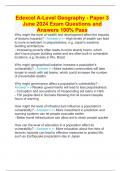Edexcel A-Level Geography - Paper 3
June 2024 Exam Questions and
Answers 100% Pass
Why might the level of wealth and development affect the impacts
of tectonic hazards? - Answer>>- High levels of wealth can lead
to more investment in preparedness, e.g. Japan's aseismic
building architecture
- Increasing poverty often leads to more shanty towns, which
don't have proper building codes and are often built in vulnerable
locations, e.g. favelas in Rio, Brazil
Why might geographical isolation increase a population's
vulnerability? - Answer>>More isolated communities will take
longer to reach with aid teams, which could increase the number
of preventable deaths
Why might governance affect a population's vulnerability? -
Answer>>Weaker governments will lead to less preparedness:
- Corruption and accusations of misspending aid loans in Haiti
- 150 people died in Somalia following the 04 tsunami despite
hours of warning
How might the level of infrastructure influence a population's
vulnerability? - Answer>>- More investment in prediction and
warning systems can let people evacuate earlier
- Better travel infrastructure can allow aid to reach people quicker
How can the level of education in a population affect its
vulnerability? - Answer>>- More education about the risks of
tectonic hazards can lead to effective measures to protect life,
such as Earthquake preparation day in Japan
,What were the impacts of the Pinatubo eruption? -
Answer>>More than 800 died, 1.2 million left homeless, $700
million in economic damage, 15-20 million tonnes of SO2 caused
global cooling of 0.6 degrees Celsius and farmland was
destroyed, making 650,000 lose their jobs.
What physical factors increased the severity of the Pinatubo
eruption? - Answer>>It was a VEI 6 eruption, many settlements
are built in coastal lowlands, increasing the risk of lahars, or on
the steep mountainsides, increasing the risk of pyroclastic flows
and tephra. Also, Typhoon Yunya had just struck, which people
had not recovered from, and provided water for lahars.
What human factors increased the risk of the Pinatubo eruption? -
Answer>>Many settlements have a high population density due
to rapid urbanisation, so 25% of the population lived in poverty in
sub-par housing that would collapse under ash. Also, the Aeta
tribe that lived near the volcano refused to evacuate, increasing
the death toll.
When and where did the Eyjafjallajökull eruption occur? -
Answer>>2010, on the Mid Atlantic Ridge, at a VEI 4 eruption
What were the impacts of the Eyjafjallajökull eruption? -
Answer>>Airlines lost $1.7 billion due to grounded flights, and
over 10 million people were stranded for over a week. However,
video facilities were more heavily used, increasing a global link.
800 people surrounding the volcano were evacuated
What physical factors increased the severity of the Eyjafjallajokull
eruption? - Answer>>Large glacial deposits at the peak of the
volcano were melted to create steam, heavily increasing the
severity of the CO2 cloud that was released.
,What human factors increased the severity of the Eyjafjallajokull
eruption? - Answer>>The active tourist industries around the
world lead to millions of people being stranded, heavily increasing
the cost of the disaster.
When and where did the Haiti earthquake occur? -
Answer>>Port-au-Prince, 2010, with a 7.0 magnitude
What were the impacts of the Haiti earthquake? -
Answer>>250,000 people died, 2 million people were made
homeless, the poverty level jumped to 72%, and $7.8 billion worth
of damage occured.
What physical factors increased the severity of the Haiti
earthquake? - Answer>>The focus was only 13km deep and the
epicentre was 24km from the capital and the steep terrain on
many poorly built houses were constructed lead to landslides.
What human factors increased the severity of the Haiti
earthquake? - Answer>>The capital was densely populated,
most doctors were killed in building collapses, and most buildings
were built of concrete, which collapse easily, increasing risk.
When and where did the NZ earthquake occur? -
Answer>>Christchurch, 2011, with a 6.3 magnitude
What were the impacts of the Christchurch earthquake? -
Answer>>185 people died, 80% of water and sewage systems
were destroyed, and 200,000 tonnes of silt were upturned due to
liquefaction.
What physical factors increased the severity of the NZ
earthquake? - Answer>>The focus was 3km deep and the
, epicentre was 5km from the CBD, and the loose rock types of the
area lead to increased liquefaction.
What human factors increased the severity of the NZ earthquake?
- Answer>>Houses had been built on areas of poor geology,
leading to increased levels of homelessness in the short term,
which could have been avoided.
When and where did the China earthquake occur? -
Answer>>Sichuan, 2008, with a 7.9 magnitude
What were the impacts of the China earthquake? -
Answer>>Over 70,000 people died, 5 million buildings collapses
and over $86 billion worth of economic damage was sustained.
What physical factors increased the severity of the China
earthquake? - Answer>>The focus was only 10km deep, and
the mountainous relief increased the risk of landslides, which
cause major damage.
What human factors increased the severity of the China
earthquake? - Answer>>The high immediate damage led to
panic, which ended more lives, and the relative poor people in
comparison to the rest of China lived in houses of a poorer
quality, which collapsed more easily.
When did the Indian Ocean Tsunami occur? - Answer>>Boxing
Day, 2004, caused by a magnitude 9.1 earthquake
What were the impacts of the Boxing Day tsunami? -
Answer>>250,000 people died and 1.7 million were made
homeless, and the tourism industry lost around $25 million/week.




